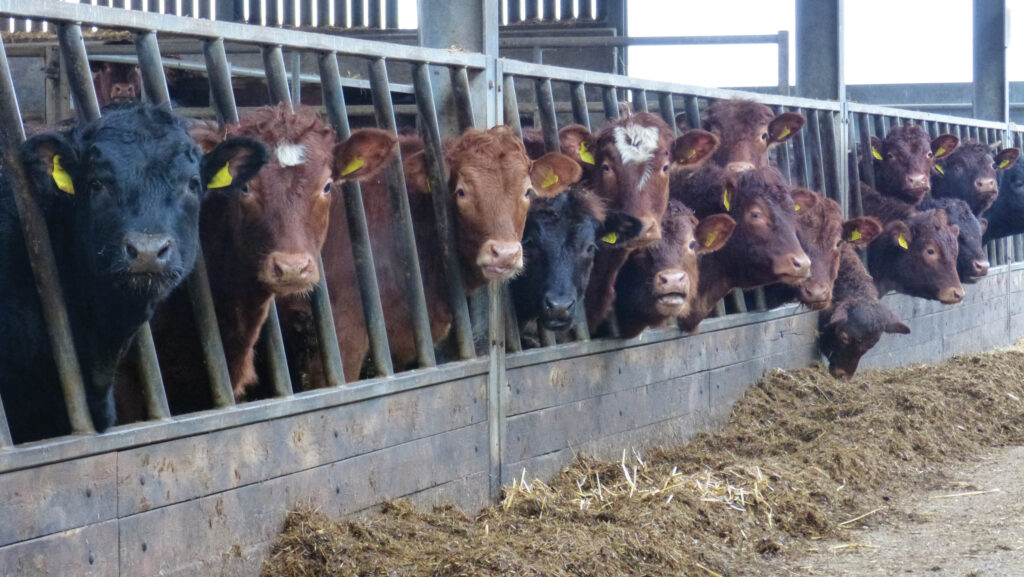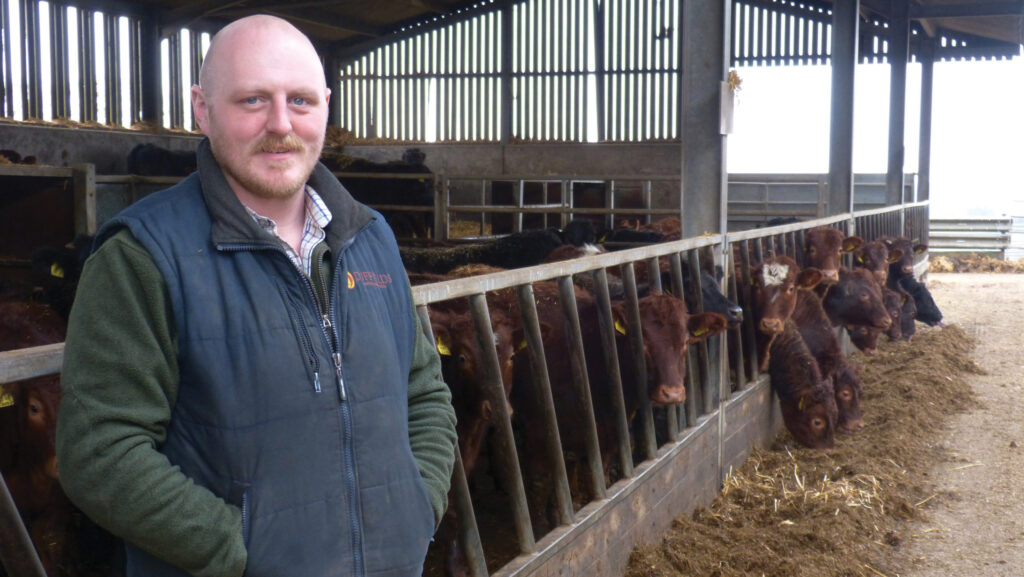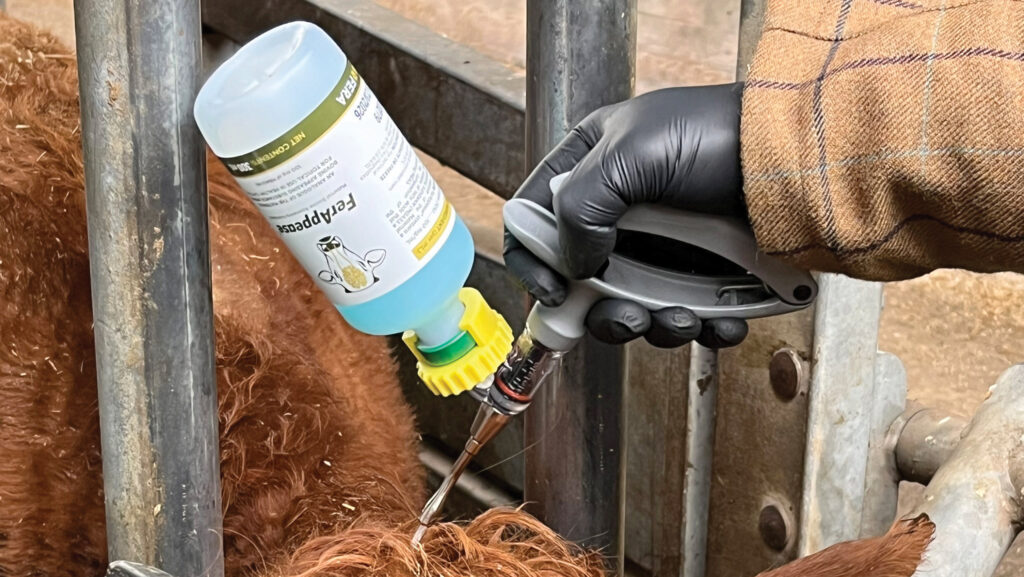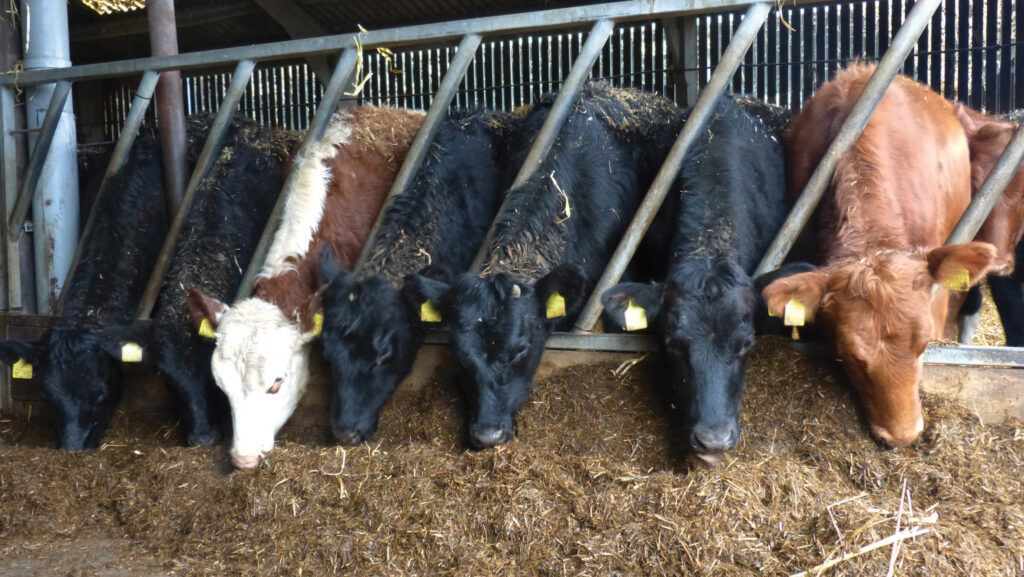Post-weaning cattle growth rates double with natural spot-on
 © MAG/Michael Priestley
© MAG/Michael Priestley A family butcher is expecting to see days to slaughter fall in cattle treated with a topical pheromone that has improved growth rates after weaning and castration.
When Steve Conisbee’s vets suggested he trial an American maternal bovine appeasing substance (MBAS) on his 2024-born calf crop to see if they would grow better, he was very cynical.
However, the impact on animal behaviour and weight gain in the cattle at Barracks Farm, Fetcham, Surrey, was so marked that Steve, a ninth-generation butcher, and his son Will have become converts.
See also: 3 weaning strategies explored for suckler farms
“When I was first approached about applying it to our calves at weaning, I was very sceptical,” admits Steve, whose family’s butchery business dates to 1760.
“But the difference between the calves given the product and those without was night and day.”
Prior to taking part in the trial, the Conisbees had taken a straightforward approach to weaning. “We didn’t see it as a problem,” says Will.
“Calves bawled their heads off for a few days after weaning and you accepted it as normal.”
Farm Facts

Will Conisbee © MAG/Michael Priestley
Barracks Farm, Fetcham, Surrey
- 165 suckler cows bred to Sussex and Limousin bulls
- Flying flock of 300 Suffolk Mules
- 2,000 turkeys reared for Christmas
- 582ha farmed
- 400ha of grassland, mostly permanent pasture and grass parks
- 182ha of arable land growing wheat, barley and maize, plus stubble turnips for finishing lambs
- Turkeys, lambs, and most prime cattle sold through F Conisbee & Son and other local butchers
- 120 native-cross dairy beef calves bought privately and finished
- Excess cattle sold to ABP
Weaning system
Traditionally, calves return to Barracks Farm to be processed in October after a summer spent grazing low-input permanent pasture.
From June, at three to five months old, they are fed crushed home-grown barley treated with a urea/alkaline-treated product, to ease the weaning transition.
Creep intakes top at about 2.2kg/day (peaking at 80kg/day for a group of 35 calves). The same feed is included in the chopped silage ration fed after weaning, helping rumen stability.

© Olly Giles
After separation, cows and calves are yarded on adjacent straw courts.
A week or so later, when the cows have dried up, they are trucked nine miles to a 100ha (247-acre) block of rented sandy arable land to outwinter on maize stubbles, kale, and supplementary hay and silage.
Cows calve on this ground in the spring.
Three weeks after weaning, heifers and bulls are split. Bull calves are surgically castrated, while heifers are grouped, synchronised and served with Wagyu or Angus straws to produce high-quality beef for the butchery.
Surplus heifers are finished in under 30 months.
Weaned calves are fed a total mixed ration of 75% grass silage, 15% maize, 5% crushed barley and 5% molasses, fed through a SiloKing mixer wagon.
At 400-420kg, they move onto a 120-day finisher diet of 12kg of maize silage, 6kg of barley, 2kg of grass silage, and 2kg of molasses a day to finish at about 550kg liveweight (the team still carries quarter carcasses into the shop).
Weaning and castration trial
Last year, farm vets Olly Giles and Rob Drysdale of Ruminant Health Solutions suggested the Conisbees try the MBAS product – called Ferappease – to help manage the stress around weaning and castration.
A group of 50 control calves and 50 treated with the product (see “How does maternal bovine appeasing substance work?”) were compared at weaning last October.
The only change to the usual weaning process was the MBAS treatment, administered at the point of weaning.
Calves were weighed at weaning and again three weeks later, after being housed in their usual straw-bedded cattle courts.
Control calves were weighed at weaning and again four weeks later (rather than three), to suit labour availability and logistics.
In December, 70 days after weaning, bull calves were surgically castrated, at which point all trial calves were weighed again.
The trial found:
- Heifers and bull calves given MBAS grew at double the daily liveweight gain (DLWG) from weaning to their second weighing 21 days later (0.7kg/day versus 0.35kg/day)
- DLWG in treated calves from 21-70 days post-weaning was 0.2kg greater
- In total, the treated calves grew 12.5kg more over the 70-day trial.
At a conservative price of £3/kg, these 300kg stores treated with MBAS would be worth £37.50 more. Each application of MBAS cost £3.50, meaning a net benefit of £30.50 an animal.
Vet Olly Giles, who has tested the product with dairies, beef units and dairy beef calf rearers across the UK, says it has been peer-reviewed in the US, and more UK farms are giving it a try.
More than 16 million doses of Ferappease have been sold in the US over the past 12 months.
“Steve rang me and asked if the trial could be cancelled.
“Disheartened, I asked why, and he said because the calves given MBAS were so calm and quiet compared with the others, it felt wrong to not treat the control calves too,” he says.
Rob points out that a cost benefit analysis would also need to include saved feed days and any reductions in antibiotics treatments and mortality.
Animal behaviour
Steve says the difference between the two groups of calves was enormous.
“The treated calves were quieter and then set to eating their ration.
“The following morning, the treated calves had eaten all their food and were lying cudding, while the control group had barely touched their food and were all stood up and calling for their mums.”
He believes that quieter animals, eating more, will be more efficient converters of feed. “It will be interesting to see if that benefit is carried right through to slaughter,” he adds.

© MAG/Michael Priestley
Other uses
The Conisbees have also used MBAS on dairy cross beef calves they buy privately. Olly administers the treatment to calves when they are given their pneumonia vaccinations on their dairy farm of origin.
This winter, Will also tried it on the rams when he was gathering them up after the tupping period. “It clearly calmed them down and stopped them head butting,” he says.
How does maternal bovine appeasing substance work?
- Application 5ml is applied behind the poll (where a sweat gland is located) and 5ml applied behind the muzzle on animals weighing more than 90kg.
- Ingredients Naturally occurring fatty acids (including coconut oil) mixed with mineral oil emulate the naturally occurring maternal bovine appeasing substance (MBAS) produced by the udder cleft
- Method of action In a stressful situation, the amygdala in the brain perceives a threat. This activates the hypothalamic-pituitary-adrenal (HPA) axis, releasing the stress hormone cortisol. The calf smells the MBAS product, which desensitises the amygdala, so no cortisol (stress hormone) is released from the adrenal glands, and the animal feels safe, and eats and behaves optimally.
- Availability The absence of any medicinal ingredients means Ferappease does not require a prescription. Being new to the UK, it is currently only available through vets.
- Uses US cattle producers use it to manage the stress of weaning, castration, sale days, haulage, and to deliver breeding bulls. Trials have found Ferappease eases transition for dairy heifers, lifting subsequent milk yield.
